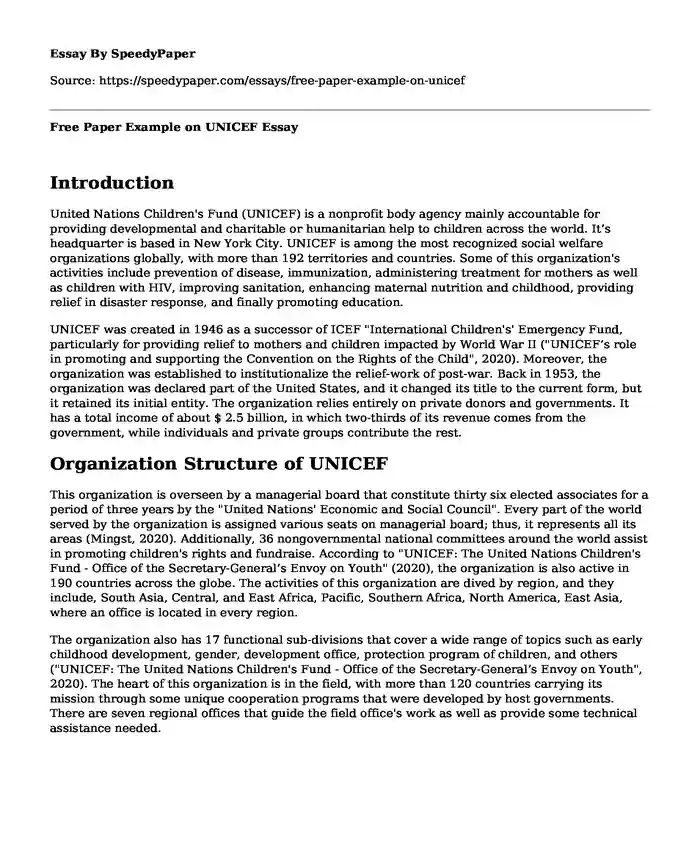
| Type of paper: | Essay |
| Categories: | Company Management |
| Pages: | 3 |
| Wordcount: | 730 words |
Introduction
United Nations Children's Fund (UNICEF) is a nonprofit body agency mainly accountable for providing developmental and charitable or humanitarian help to children across the world. It’s headquarter is based in New York City. UNICEF is among the most recognized social welfare organizations globally, with more than 192 territories and countries. Some of this organization's activities include prevention of disease, immunization, administering treatment for mothers as well as children with HIV, improving sanitation, enhancing maternal nutrition and childhood, providing relief in disaster response, and finally promoting education.
UNICEF was created in 1946 as a successor of ICEF "International Children's' Emergency Fund, particularly for providing relief to mothers and children impacted by World War II ("UNICEF’s role in promoting and supporting the Convention on the Rights of the Child", 2020). Moreover, the organization was established to institutionalize the relief-work of post-war. Back in 1953, the organization was declared part of the United States, and it changed its title to the current form, but it retained its initial entity. The organization relies entirely on private donors and governments. It has a total income of about $ 2.5 billion, in which two-thirds of its revenue comes from the government, while individuals and private groups contribute the rest.
Organization Structure of UNICEF
This organization is overseen by a managerial board that constitute thirty six elected associates for a period of three years by the "United Nations' Economic and Social Council". Every part of the world served by the organization is assigned various seats on managerial board; thus, it represents all its areas (Mingst, 2020). Additionally, 36 nongovernmental national committees around the world assist in promoting children's rights and fundraise. According to "UNICEF: The United Nations Children's Fund - Office of the Secretary-General’s Envoy on Youth" (2020), the organization is also active in 190 countries across the globe. The activities of this organization are dived by region, and they include, South Asia, Central, and East Africa, Pacific, Southern Africa, North America, East Asia, where an office is located in every region.
The organization also has 17 functional sub-divisions that cover a wide range of topics such as early childhood development, gender, development office, protection program of children, and others ("UNICEF: The United Nations Children's Fund - Office of the Secretary-General’s Envoy on Youth", 2020). The heart of this organization is in the field, with more than 120 countries carrying its mission through some unique cooperation programs that were developed by host governments. There are seven regional offices that guide the field office's work as well as provide some technical assistance needed.
Management
The management of this association take place in always in it headquarter. The supply division of this organization is also located in Copenhagen and it serve as the original place of essential dispersal of antiretroviral medicines, lifesaving vaccines, nutrient supplements, education suppliers, and emergency shelter ("UNICEF: The United Nations Children's Fund - Office of the Secretary-General’s Envoy on Youth", 2020). The monitoring and the guiding of UNICEF's work are done by 36 members of the executive board that also establishes policies, financial plan, oversees administrative, and finally, approve programs. Moreover, the managerial part of the organization also constitute government agents who are mainly designated by the "United National Economic and the social council.”
Conclusion
Unlike many NGOs, UNICEF is accountable to the government since it is an intergovernmental organization. Being responsible to the government helps the organization access as well as reach many every corner of the world, but it hampers its ability to speak out on violation rights. However, it is always mandated to protect the rights’ of children and assist them in meeting their basic needs and create chance of achieving their full potential by the United Nations General Assembly.
References
About UNICEF. Unicef.org. (2020). Retrieved 18 September 2020, from
https://www.unicef.org/about-unicef.
Jolly, R. (2014). UNICEF (United Nations Children's Fund): Global Governance that Works. Routledge.
Mingst, K. (2020). UNICEF Definition, History, & Facts. Encyclopedia Britannica. Retrieved 18 September 2020, from https://www.britannica.com/topic/UNICEF.
Rogers, P. J. (2014). Overview of impact evaluation. UNICEF Office of Research-Innocenti.
UNICEF. Unicef.org. (2020). Retrieved 18 September 2020, from
https://www.unicef.org/.
UNICEF: The United Nations Children's Fund - Office of the Secretary-General’s Envoy on Youth. Office of the Secretary-General’s Envoy on Youth. (2020). Retrieved 18 September 2020, from https://www.un.org/youthenvoy/2013/09/unicef-the-united-nations-childrens-fund/.
UNICEF’s role in promoting and supporting the Convention on the Rights of the Child. Unicef.org. (2020). Retrieved 18 September 2020, from
https://www.unicef.org/child-rights-convention/unicef-role.
Cite this page
Free Paper Example on UNICEF. (2023, Nov 29). Retrieved from https://speedypaper.com/essays/free-paper-example-on-unicef
Request Removal
If you are the original author of this essay and no longer wish to have it published on the SpeedyPaper website, please click below to request its removal:
- Project Management: Team Management
- Free Essay Example on Scrum-based Software
- The New Pay Plan Essay Sample
- Essay Example on Handmade Company's Network Management and Security
- Risk Analysis of Nissan Corporation, Free Essay Example
- Essay Example: ISACA Certifications
- Essay Sample on How Duke Energy and Tesla Make Money
Popular categories




